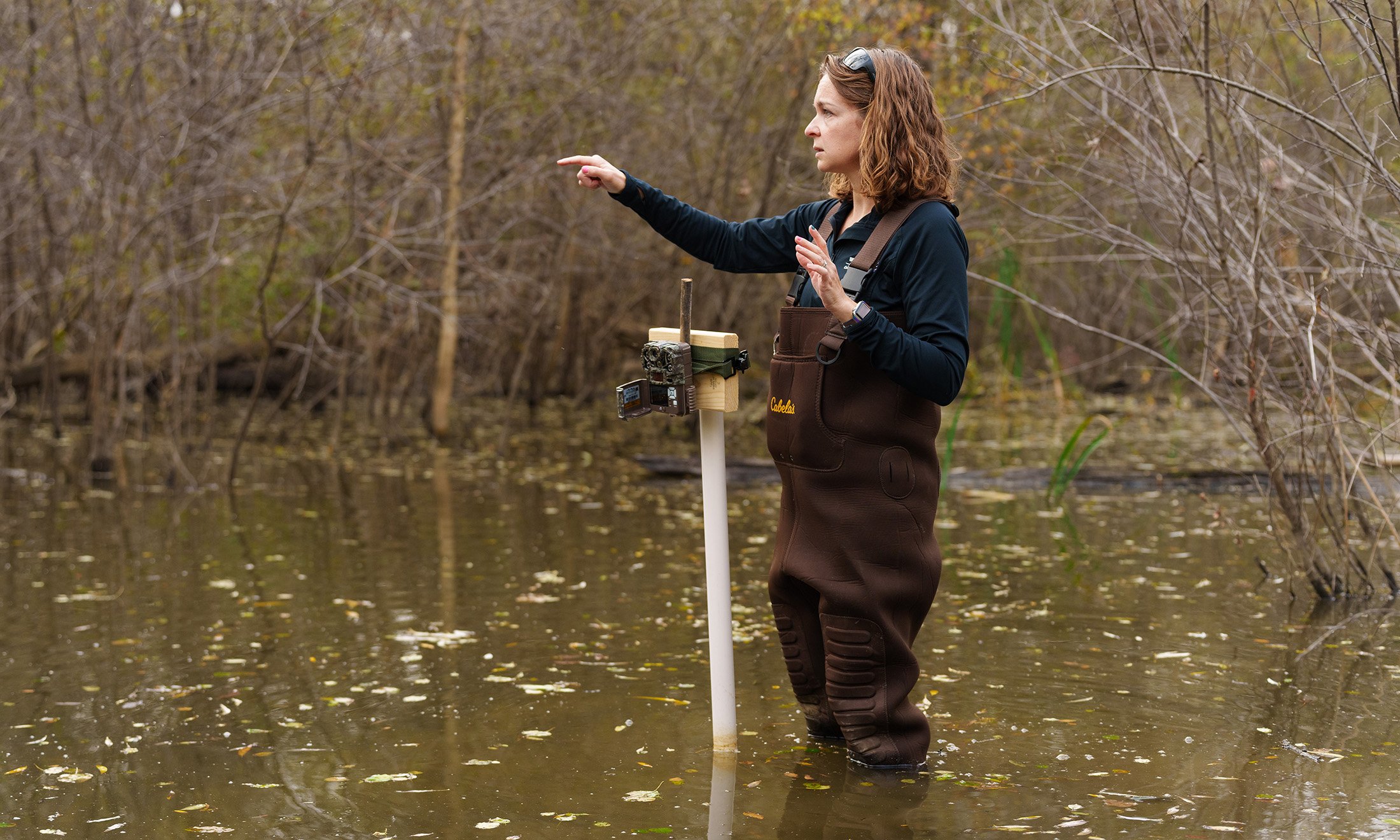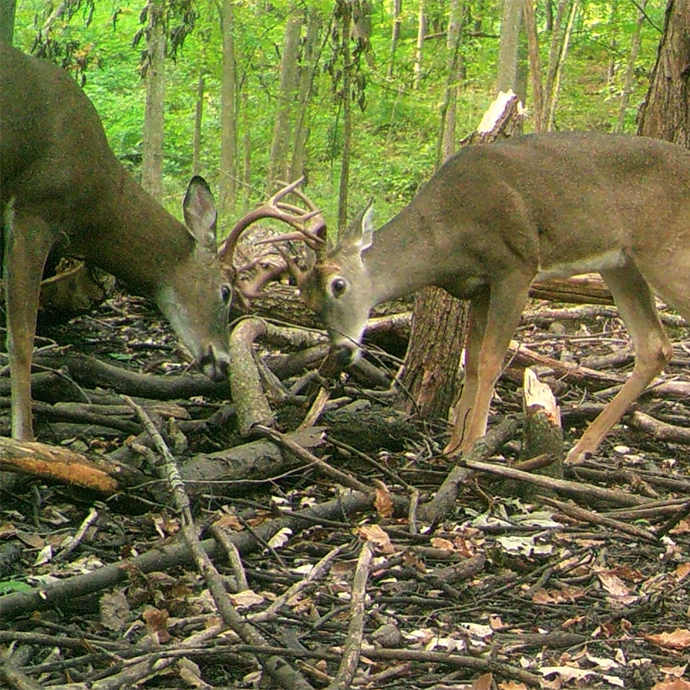- YouTube
- TikTok
Preserving the Preserve
OU faculty find ways to help animals thrive and prosper inside OU’s biopreserve

Photo by Robert Hall | Sandra Troxell-Smith, Ph.D., special lecturer in the Department of Biological Sciences, sets up trail cameras throughout the OU Biological Preserve to capture photos and track the animals within the preserve.
Biological Sciences
 April 02, 2025
April 02, 2025
 By Kelli M. Warshefski
By Kelli M. Warshefski
“For many of these species, the biopreserve is a safe space where they can prosper,” explains Sandra Troxell-Smith, Ph.D., biological sciences special lecturer. “It is very important that we preserve the preserve as much as possible.”
Equipped with three bird camera feeders and more than 20 trail cameras, Dr. Troxell-Smith and her students monitor and record the animals found with Oakland University’s biological preserve. To date, they have recorded 16 mammals and nearly 30 different types of birds.
|
Birds |
Rose-Breasted Grosbeak Mammals |
 |
| Two bucks captured on one of the trail cameras within the OU biopreserve. |
“Many students don’t even realize that the preserves are part of campus,” Troxell-Smith says. “It’s one thing to have a deer crossing your path when you’re trying to drive onto campus, but it’s something else to be able to see [with the trail cameras] a doe with her fawn in their natural habitat. It’s really exciting.”
Snapshot USA
As part of her Topics in Behavioral Biology (BIO 4350/5350) course, Troxell-Smith and her students set up trail cameras in various areas around the biopreserve, and trek to the locations once a week to replace the memory cards and switch out camera batteries. They then carefully review all the images, discarding the shots where leaves or branches triggered the camera. Troxell-Smith says they can have more than 100 hits per week of potential animal activity.
 |
| Coyote captured on trail camera in OU biopreserve |
Oakland University recently became part of Snapshot USA, a national survey that collaborates with ecologists from universities or organizations to track wildlife populations. “It’s an initiative run by the Smithsonian National Zoo and Conservation Biology Institute where they utilize citizen science to get a good sense of the mammalian species throughout the United States, and how those populations change over time” says Troxell-Smith.
“Last fall was the first time we contributed to this effort, which wouldn’t have been possible without the hard work of Brooke Mechlowitz (independent research student in Biology) and Brittany Greene (graduate student in Psychology),” she adds. “We’re really looking forward to doing it again this fall as part of the Topics in Behavioral Biology course because it’s a great opportunity to contribute directly to a nationwide dataset,” she adds.
Beaver Discovery
 |
| A male and female beaver create a home in the OU biopreserve. “We are hoping to see baby beavers this spring,” says Troxell-Smith. |
One of the most exciting finds in recent years was the discovery of a beaver dam in December 2023. Currently, there is evidence of two beavers that created a dam under a bridge on one of the biopreserve trails. The biological sciences, English and psychology departments, along with the Native American Advisory Committee, are working together to monitor the beaver activity.
“The beaver — Amik in Ojibwe — is a sacred animal relative that we can learn from and have a reciprocal relationship with,” says Ashleigh Dubie (tribal affiliation Cherokee), CAS ’22, in a 2024 article about the discovery of the beavers. “By monitoring its impact on the environment it has decided to now call home, we should in turn be making decisions to help the beaver thrive, as we are currently trying to do. This is what Indigenous relationships with the environment look like and have looked like for thousands of years — scientifically proven relationships that indicate reciprocal care. We — Native and non-Native community members alike — are lucky to bear witness to this on OU’s campus.”
To aid in the efforts of coexisting with the beavers, Oakland University has created a Beaver Remediation Fund.
Bird Tracking
To better understand the variety of bird species found in the biopreserve, three solar-powered Bird Buddy bird feeders were installed near the preserve. Supported by the Department of Biological Sciences and an OU Women and Philanthropy grant, these feeders contain motion-activated cameras, which send videos and photos of visiting birds to an app. Each feeder contains different types of seed to attract different species, allowing Troxell-Smith and her students an up-close look at the birds on campus.
 |
| Red-bellied woodpecker captured on Bird Buddy. |
“We’ve completed several different experiments to see which birds prefer certain types of food, and how the species we see at the feeders change depending on season,” Troxell-Smith says. “Students in the animal behavior lab (BIO 3351) get the opportunity to come up with a hypothesis about what species they are trying to attract, decide what food to provide in the feeders to attract them, and evaluate whether their hypothesis is supported based on the information they retrieve from the app,” says Troxell-Smith. Outside of the lab sessions, Gina Montalto (graduate student in psychology) and Isabella Limbert (graduate student in biological sciences) have been collecting data and maintaining the feeders year-round to monitor how factors like seasonality and migration impact the species that visit the feeders.
Explore more about the animals at OU at Animal Behavior Facebook and Animal Behavior Instagram.








